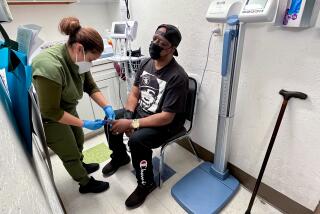Need a breath of fresh oxygen?
Oxygen is one of those non-negotiable items in life. You can skimp on food, sunlight and, in emergency situations, morning coffee, but you can’t last more than a couple of minutes without oxygen. The vital gas makes up about 20% of the air we breathe.
The product: If 20% sounds skimpy, you can always try breathing 90% pure oxygen from an Oxygen+Stick (pronounced “oxygen plus stick”), a hand-held device sold over the Internet and at resorts and health spas across the country.
The colorful sticks, a little over 8 inches long, hold replaceable canisters that are good for about 50 puffs each.
The Oxygen Plus website offers a stick and two canisters (one “natural flavor,” one peppermint) for $34, or about 34 cents per puff.
The claims: According to the website, just five blasts of the Oxygen+Stick will provide an “instant energy boost” that’s a “natural alternative to caffeine.” The site recommends using the device “at the first signs of fatigue or a drop in energy or alertness.” The device is said to be especially energizing after workouts, air travel or “a big night out.”
Kevin Berigan, president of Oxygen Plus, the company that manufactures and sells the sticks, says individual results vary. “A lot of people report feeling a mental and physical boost immediately,” he says. “It can be mild to dramatic.” He says that the ranks of satisfied customers include doctors, nurses and pilots.
In conversation, press releases and on his website, Berigan points to two studies that supposedly validate the Oxygen+Stick. A 2004 study by members of the U.S. Olympic Committee found that extra oxygen improved the stamina of elite athletes training at high altitude, and a 1999 British study showed that oxygen boosted the thinking skills of young volunteers. In both studies, subjects received not puffs from a hand-held device but continuous flows of oxygen from large tanks.
Bottom line: The Oxygen+Stick didn’t create instant energy in a two-person newsroom test. There were also no reports of unusual mental sharpness. (To be fair, neither subject was trying to recover from a workout or a “big night out,” and both were relatively sharp to begin with.)
It’s no surprise that the stick didn’t provide the promised jolt, says Carl Foster, an exercise physiologist at the University of Wisconsin-La Crosse and a past president of the American College of Sports Medicine. Even if a person huffed Oxygen+Sticks all day until drifts of empty canisters filled the room, “there’s no way this could do anything,” he says.
Most people already get plenty of oxygen, Foster says. The blood of healthy people at sea level is nearly saturated with the gas, and a small increase wouldn’t make much difference. (People with emphysema or other lung diseases do suffer from shortfalls of oxygen, but the Oxygen+Stick isn’t intended to treat illness.) Even if a person were gasping for air at the top of a mountain, he says, an Oxygen+Stick could help for only a few seconds. “By the time you put it back in your pocket and take another breath, you’re right back to where you started.”
In general, tiredness has nothing to do with oxygen levels, says Dr. Peter Wagner, professor of Medicine and Bioengineering at UC San Diego and a past president of the American Thoracic Society. He explains that workouts are exhausting because muscle cells run out of energy to burn, not because the body runs out of oxygen. Only hard-core athletes -- the kind who can go through 150 liters of air per minute -- ever have any kind of oxygen shortfall while exercising, he says.
If you still want a quick oxygen boost on demand, Wagner says there’s a cheaper option: It’s called a deep breath.
*
Is there a consumer product you’d like the Healthy Skeptic to examine? E-mail the details to health@latimes.com.


